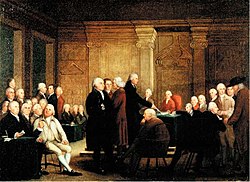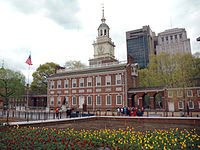
Back الكونغرس القاري الثاني Arabic İkinci Kontinental Konqres Azerbaijani Икенсе Континенталь конгресс Bashkir Другі Кантынентальны Кангрэс Byelorussian Другі Кантынэнтальны кангрэс BE-X-OLD Segon Congrés Continental Catalan Druhý kontinentální kongres Czech Zweiter Kontinentalkongress German Segundo Congreso Continental Spanish Toinen mannermaakongressi Finnish
Second Continental Congress | |
|---|---|
| Part of the American Revolution | |
 | |
| Type | |
| Type | |
| History | |
| Established | May 10, 1775 |
| Disbanded | March 1, 1781 |
| Preceded by | First Continental Congress |
| Succeeded by | Congress of the Confederation |
| Leadership | |
Secretary | |
| Seats | Variable; ~60 |
| Meeting place | |
 | |
| Assembly Room, Pennsylvania State House, Philadelphia, Pennsylvania Under exigent circumstance also met at: Henry Fite House, Baltimore, Maryland; Court House, Lancaster, Pennsylvania; Court House, York, Pennsylvania; College Hall, Philadelphia, Pennsylvania | |
| This article is part of a series on the |
| United States Continental Congress |
|---|
 |
| Predecessors |
| First Continental Congress |
| Second Continental Congress |
| Congress of the Confederation |
| Members |
| Related |
|
|
The Second Continental Congress (1775–1781) was the meetings of delegates from the Thirteen Colonies that united in support of the American Revolution and the Revolutionary War, which established American independence from the British Empire. The Congress constituted a new federation that it first named the United Colonies of North America, and in 1776, renamed the United States of America. The Congress began convening in Philadelphia, on May 10, 1775, with representatives from 12 of the 13 colonies, after the Battles of Lexington and Concord.
The Second Continental Congress succeeded the First Continental Congress, which had met from September 5 to October 26, 1774, also in Philadelphia. The Second Congress functioned as the de facto federation government at the outset of the Revolutionary War by raising militias, directing strategy, appointing diplomats, and writing petitions such as the Declaration of the Causes and Necessity of Taking Up Arms and the Olive Branch Petition.[1] All 13 colonies were represented by the time the Congress adopted the Lee Resolution, which declared independence from Great Britain on July 2, 1776, and the Congress unanimously agreed to the Declaration of Independence two days later.
Congress functioned as the provisional government of the United States of America through March 1, 1781, when congress became what is now often called the Confederation Congress. During this period, it successfully managed the war effort, drafted the Articles of Confederation and Perpetual Union, adopted the first U.S. constitution, secured diplomatic recognition and support from foreign nations, and resolved state land claims west of the Appalachian Mountains.
Many of the delegates who attended the Second Congress had also attended the First. They again elected Peyton Randolph as president of the Congress and Charles Thomson as secretary.[2] Notable new arrivals included Benjamin Franklin of Pennsylvania and John Hancock of Massachusetts. Within two weeks, Randolph was summoned back to Virginia to preside over the House of Burgesses; Hancock succeeded him as president, and Thomas Jefferson replaced Randolph in the Virginia delegation.[3] The number of participating colonies also grew, as Georgia endorsed the Congress in July 1775 and adopted the continental ban on trade with Britain.[4]
- ^ Cogliano (2000), p. 113.
- ^ Burnett, Edward Cody (1941). The Continental Congress. New York: Norton. pp. 64–67.
- ^ Fowler, William M. Jr. (1980). The Baron of Beacon Hill: A Biography of John Hancock. Boston: Houghton Mifflin. p. 189. ISBN 0395276195.
- ^ Cashin, Edward J. (2005). "Revolutionary War in Georgia". New Georgia Encyclopedia. Georgia Humanities and the University of Georgia Press. Retrieved April 22, 2019.